Evaluating Accessibility Solutions in Collective Residential Buildings: Field Research in Southeast Spain
Abstract
1. Introduction
2. Materials and Methods
2.1. Accessibility Regulations
2.2. Checklist of Accessibility and Definition of Accessibility Solutions
- The first solution to be considered is to communicate the lift, if it exists, with the outside space via an accessible route, known as bringing the lift to level 0. An example of this case is shown in Figure 1. The entrance to the building is done via stairs that are completely inaccessible to people with disabilities (as shown in Figure 1a). After the intervention, the entrance level was lowered, so that the elevator was at level 0 (as shown in Figure 1b).
- If this solution is not viable, it is suggested that a ramp is placed in accordance with the conditions of the DB SUA or, if this is not possible, in accordance with the tolerances of the Supporting Document. Figure 1d presents an example of this case.These first two are the best solutions, since both are integrated options that aim to achieve the highest level of accessibility for the common areas of collective housing. In addition, these options can be applied to all users of the buildings, regardless of whether they have disabilities or not. They will, therefore, be the preferred options in the fieldwork.
- As a third level, the Support Document considers the installation of a vertical lift platform. This vertical platform serves to bridge the difference in the level of the entrance stairs within the private space of the building, giving access to the elevator.
- As a last option, the Support Document proposes the installation of an inclined lifting platform (stairlift) in marginal cases where the other options cannot be adopted. An example of this situation can be seen in Figure 2a, where a lift platform was placed to lead to the elevator.Options 3 and 4 are acceptable options, but they are only usable by people with disabilities. This means that the mentioned concepts of integration, equality, etc., are not followed. In any case, in some cases it is necessary to resort to them.
- In those cases where the accessibility cannot be resolved within the boundaries of the private space in any of the above options, the Support Document proposes the occupation of the public space, taking the necessary measures to guarantee the safety of the public space. An example of this situation can be seen in Figure 2b,c, where a ramp is planned to be placed on the sidewalk at the entrance to the building.
- In situations where other alternatives are not possible, the support document also considers the installation of motorized rails or chair saving stairs. The present research does not consider this option as an alternative. In the field work, a solution between the first five approaches is always selected in order to guarantee the autonomy of people with disabilities.
2.3. Cost Analysis of the Proposed Accessibility Solutions
- Low-cost actions (less than 40,000 EUR): internal inclined plane (4%), internal filler, internal ramp, vertical lift platform, inclined lift platform, and ramp in public areas.
- High-cost actions (more than 40,000 EUR): lift to level 0, lift in common areas, lift in internal terraces, external lift, and lift in private areas.
2.4. Description and Design of the Field Work
3. Results
4. Discussion
5. Conclusions
Author Contributions
Funding
Data Availability Statement
Conflicts of Interest
References
- World Health Organization. Global Age-Friendly Cities: A Guide; World Health Organization: Geneva, Switzerland, 2007. [Google Scholar]
- Iwarsson, S.; Ståhl, A. Accessibility, usability and universal design—Positioning and definition of concepts describing person-environment relationships. Disabil. Rehabil. 2003, 25, 57–66. [Google Scholar] [CrossRef] [PubMed]
- Steinfeld, E.; Maisel, J. Universal Design: Creating Inclusive Environments; John Wiley & Sons: Hoboken, NJ, USA, 2012. [Google Scholar]
- Null, R. (Ed.) Universal Design: Principles and Models; CRC Press: Boca Raton, FL, USA, 2013. [Google Scholar]
- Hamraie, A. Building Access: Universal Design and the Politics of Disability; University of Minnesota Press: Minneapolis, MN, USA, 2017. [Google Scholar]
- Margot-Cattin, I.; Kuhne, N.; Kottorp, A.; Cutchin, M.; Öhman, A.; Nygård, L. Development of a questionnaire to evaluate out-of-home participation for people with dementia. Am. J. Occup. Ther. 2019, 73, 7301205030p1–7301205030p10. [Google Scholar] [CrossRef] [PubMed]
- Mayordomo-Martínez, D.; Carrillo-de-Gea, J.M.; García-Mateos, G.; García-Berná, J.A.; Fernández-Alemán, J.L.; Rosero-López, S.; Parada-Sarabia, S.; García-Hernández, M. Sustainable Accessibility: A Mobile App for Helping People with Disabilities to Search Accessible Shops. Int. J. Environ. Res. Public Health 2019, 16, 620. [Google Scholar] [CrossRef] [PubMed]
- Mayordomo-Martínez, D.; Sánchez-Aarnoutse, J.-C.; Carrillo-de-Gea, J.M.; García-Berná, J.A.; Fernández-Alemán, J.L.; García-Mateos, G. Design and Development of a Mobile App for Accessible Beach Tourism Information for People with Disabilities. Int. J. Environ. Res. Public Health 2019, 16, 2131. [Google Scholar] [CrossRef] [PubMed]
- Imrie, R. The Role of the Building Regulations in Achieving Housing Quality. Environ. Plan. B Plan. Des. 2004, 31, 419–437. [Google Scholar] [CrossRef]
- Sanford, J.A. Universal Design as a Rehabilitation Strategy: Design for the Ages; Springer Publishing Company: New York, NY, USA, 2010. [Google Scholar]
- Heylighen, A.; Van der Linden, V.; Van Steenwinkel, I. Ten Questions Concerning Inclusive Design of the Built Environment. Build. Environ. 2017, 114, 507–517. [Google Scholar] [CrossRef]
- Evcil, A.N. Wheelchair accessibility to public buildings in Istanbul. Disabil. Rehabil. Assist. Technol. 2009, 4, 76–85. [Google Scholar] [CrossRef] [PubMed]
- Jamaludin, M.; Kadir, S.A. Accessibility in Buildings of Tourist Attraction: A case studies comparison. Procedia-Soc. Behav. Sci. 2012, 35, 97–104. [Google Scholar] [CrossRef]
- de Velasco Machado, L.; de Oliveira, U.R. Analysis of failures in the accessibility of university buildings. J. Build. Eng. 2021, 33, 101654. [Google Scholar] [CrossRef]
- Bodaghi, N.B.; Zainab, A.N. Accessibility and facilities for the disabled in public and university library buildings in Iran. Inf. Dev. 2013, 29, 241–250. [Google Scholar] [CrossRef]
- Welage, N.; Liu, K.P. Wheelchair accessibility of public buildings: A review of the literature. Disabil. Rehabil. Assist. Technol. 2011, 6, 1–9. [Google Scholar] [CrossRef] [PubMed]
- Carlsson, G.; Slaug, B.; Schmidt, S.M.; Norin, L.; Ronchi, E.; Gefenaite, G. A scoping review of public building accessibility. Disabil. Health J. 2022, 15, 101227. [Google Scholar] [CrossRef] [PubMed]
- United Nations. Department of Economic and Social Affairs, 2003, Accessibility for the Disabled—A Design Manual for a Barrier Free Environment. Available online: https://www.un.org/esa/socdev/enable/designm/ (accessed on 8 May 2024).
- USA Government. Americans with Disabilities Act, 2000. Accessibility Guidelines for Buildings and Facilities. Available online: https://www.federalregister.gov/documents/2004/07/23/04-16025/americans-with-disabilities-act-ada-accessibility-guidelines-for-buildings-and-facilities (accessed on 8 May 2024).
- Badawy, U.I.; Jawabrah, M.Q.; Jarada, A. Adaptation of accessibility for people with disabilities in private and public buildings using appropriate design checklist. Int. J. Mod. Trends Sci. Technol. 2020, 6, 9–15. [Google Scholar] [CrossRef]
- Hanson, J. From sheltered housing to lifetime homes: An inclusive approach to housing. In Lifetime Housing in Europe; Winters, S., Ed.; Katholieke Unversiteit Leuven: Leuven, Belgium, 2021; pp. 35–57. [Google Scholar]
- United Nations. Convention on the Rights of Persons with Disabilities. 2006. Available online: https://www.un.org/disabilities/documents/convention/convoptprot-e.pdf (accessed on 9 March 2024).
- Spanish Government. Royal Decree 450/2022, June 14, Which Modifies the Technical Building Code (Código Técnico de la Edificación), Approved by Royal Decree 314/2006, of March 17. Boletín Oficial del Estado, no. 142, 15/6/2022. Available online: https://www.codigotecnico.org/pdf/Documentos/SUA/DccSUA.pdf (accessed on 28 May 2024).
- Spanish Government. Documento de Apoyo al Documento Básico DB-SUA Seguridad de Utilización y Accesibilidad Código Técnico de la Edificación. DA DB-SUA/2 Adecuación Efectiva de las Condiciones de Accesibilidad en Edificios Existentes. Available online: https://www.codigotecnico.org/pdf/Documentos/SUA/DccSUA.pdf (accessed on 9 March 2024).
- Spanish Government. Royal Decree 314/2006, March 17, Approving the Technical Building Code (Código Técnico de la Edificación). Boletín Oficial del Estado, no. 74, de 28/03/2006. Available online: https://www.boe.es/buscar/act.php?id=BOE-A-2006-5515 (accessed on 29 March 2024).
- Government of the Region of Murcia. Law 4/2017, of June 27, on Universal Accessibility of the Region of Murcia. BOE no. 189, de 9/12/2017. Available online: https://www.boe.es/diario_boe/txt.php?id=BOE-A-2017-9488 (accessed on 29 March 2024).
- Government of the Region of Murcia. Law 5/1995, of April 7, on Habitability Conditions in Residential Buildings and Promotion of General Accessibility. BORM no. 102, of May 4, 1995, BOE no. 131, of June 2; 1995. Available online: https://www.boe.es/buscar/act.php?id=BOE-A-1995-13299 (accessed on 29 March 2024).
- Government of the Region of Murcia. Decree 39/1987, of June 4, “Elimination of Architectural Barriers”. BORM no. 185, of 14/8/1987. Available online: http://www.mldm.es/BA/PDF/DECRETO%2039%20-%201987.pdf (accessed on 29 March 2024).
- Ministry of Territorial Policy, Public Works, and the Environment of the Region of Murcia. Order of October 15, 1991, “Construction: Elimination of Architectural Barriers in Public Spaces and Buildings”. BORM no. 260, of November 11; 1991. Available online: https://www.borm.es/services/anuncio/613555/pdf (accessed on 29 March 2024).
- Spanish Government. Royal Decree 1/2013, November 29, Approving the Consolidated Text of the General Law on the Rights of Persons with Disabilities and Their Social Inclusion (Texto Refundido de la Ley General de Derechos de las Personas con Discapacidad y de su Inclusión Social). Boletín Oficial del Estado, no. 289, de 3/12/2013. Available online: https://www.boe.es/buscar/doc.php?id=BOE-A-2013-12632 (accessed on 29 March 2024).
- Spanish Government. Royal Decree-Law 7/2015, October 30, approving the revised text of the Law of Land and Urban Rehabilitation (Texto Refundido de la Ley de Suelo y Rehabilitación Urbana). Boletín Oficial del Estado, no. 261, de 31/10/2015. Available online: https://www.boe.es/buscar/act.php?id=BOE-A-2015-11723 (accessed on 29 March 2024).
- Spanish Government. Law 9/2017, of November 8, on Public Sector Contracts, Transposing into Spanish Law the Directives of the European Parliament and of the Council 2014/23/EU and 2014/24/EU, of February 26, 2014 (Ley de Contratos del Sector Público, por la que se Transponen al Ordenamiento Jurídico Español las Directivas del Parlamento Europeo y del Consejo). Available online: https://www.boe.es/buscar/act.php?id=BOE-A-2017-12902 (accessed on 9 May 2024).
- INE. Encuesta de Discapacidad, Autonomía Personal y Situaciones de Dependencia. 2008. Available online: https://www.ine.es/dyngs/INEbase/es/operacion.htm?c=Estadistica_C&cid=1254736176782&menu=resultados&idp=1254735573175 (accessed on 9 March 2024).
- Moreno-López, A.B.; Palomar-Rodríguez, J.; Forcada-Navarro, O.; Segura-Aroca, M.; Rojas-Nolasco, R.H.; Martínez-Andreu, E.; Godoy-Gázquez, M.C. Discapacidades en la Región de Murcia. Distribución Territorial y Temporal 2000–2012; Consejería de Sanidad y Política Social. Región de Murcia: Murcia, Spain, 2013; ISBN 978-84-15909-07-1. [Google Scholar]
- Imrie, R.; Hall, P. Inclusive Design: Designing and Developing Accessible Environments; Taylor & Francis: London, UK, 2003. [Google Scholar]
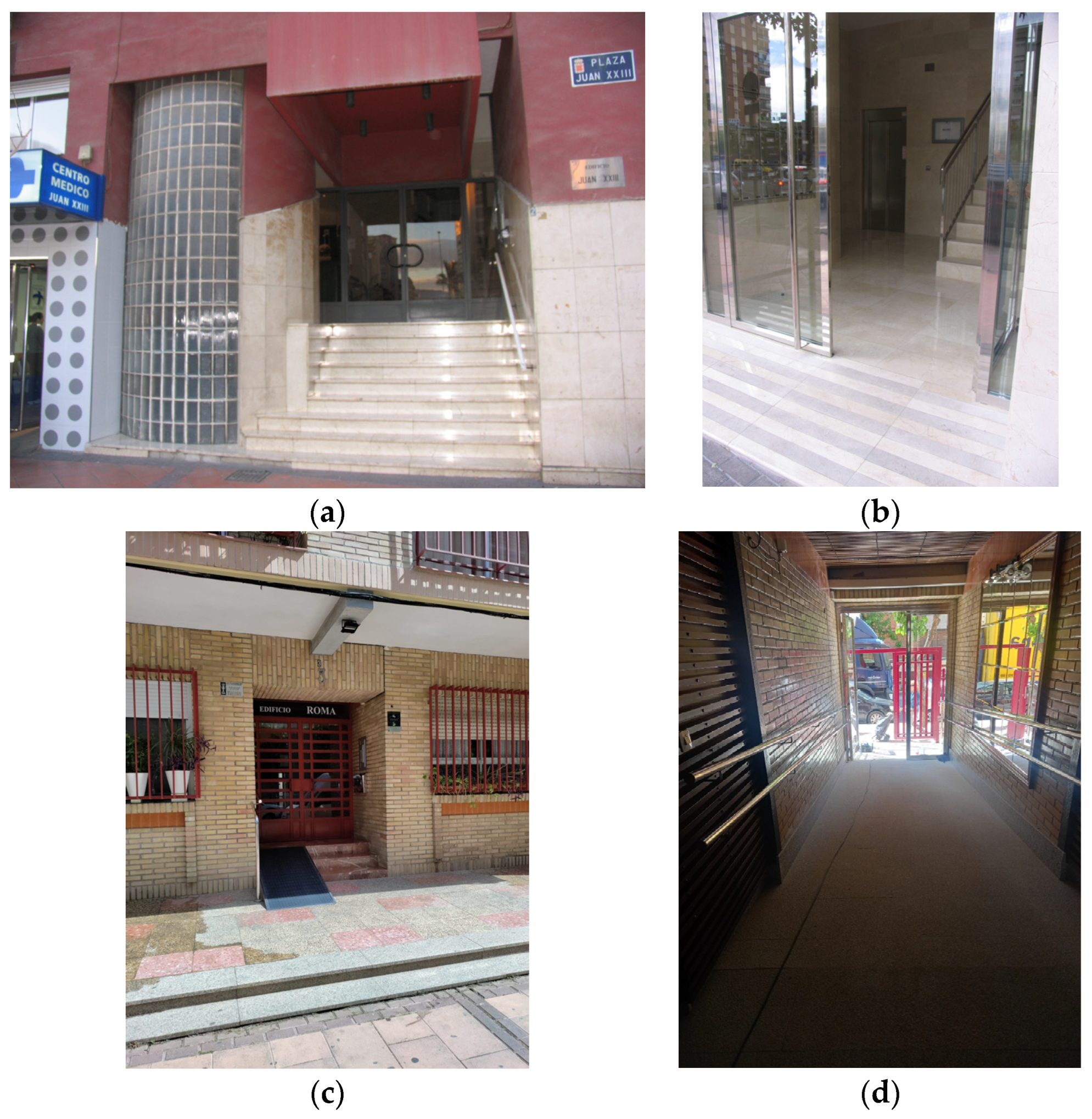
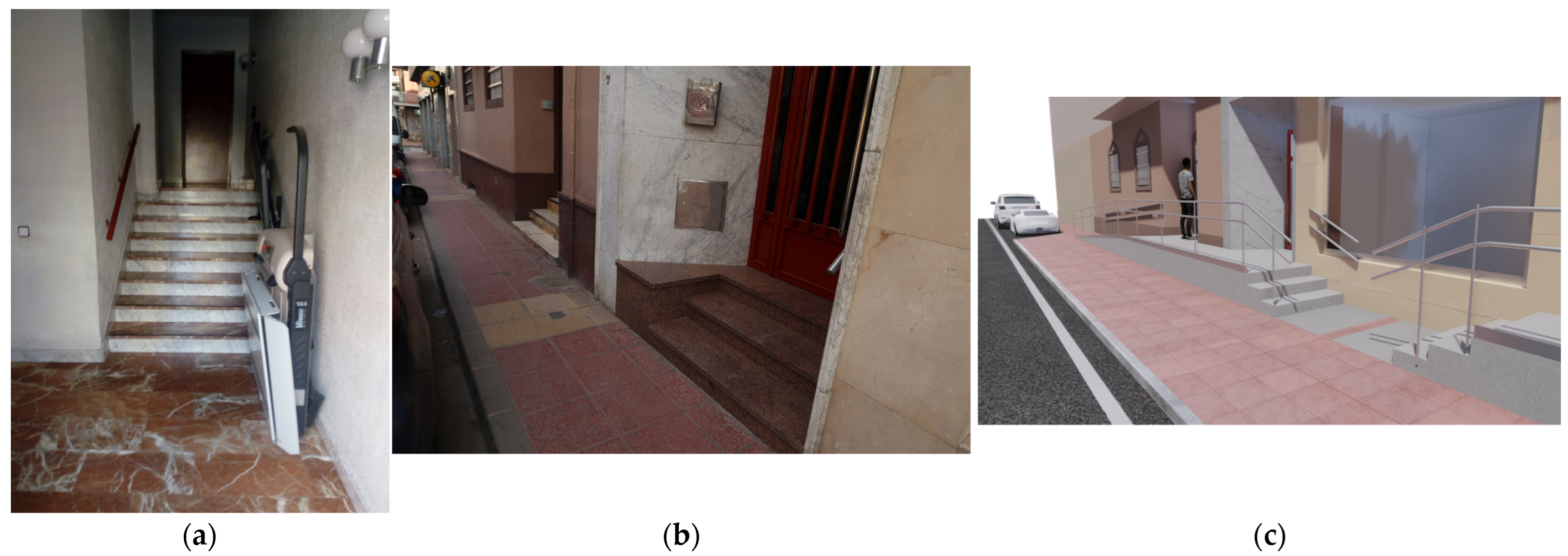
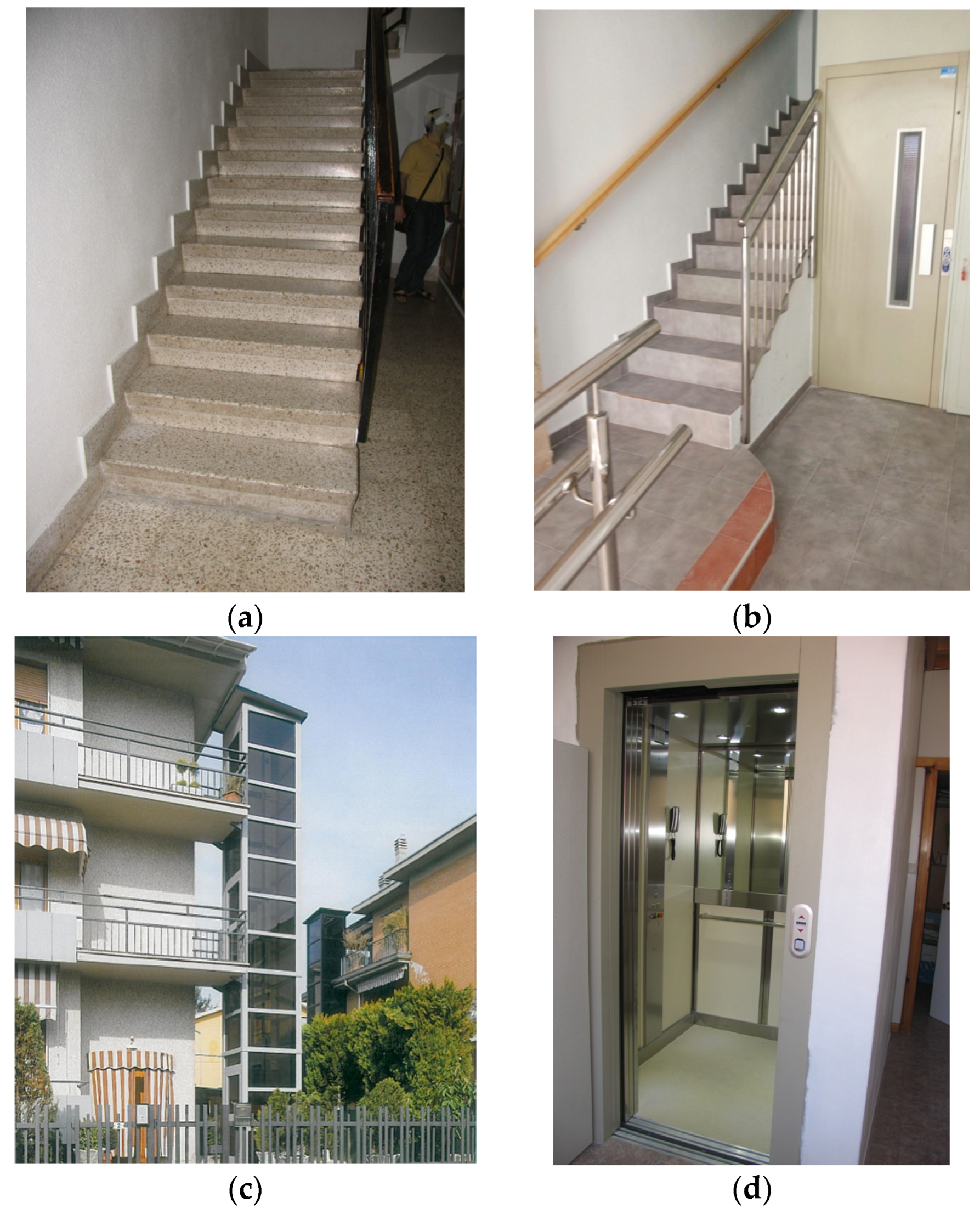
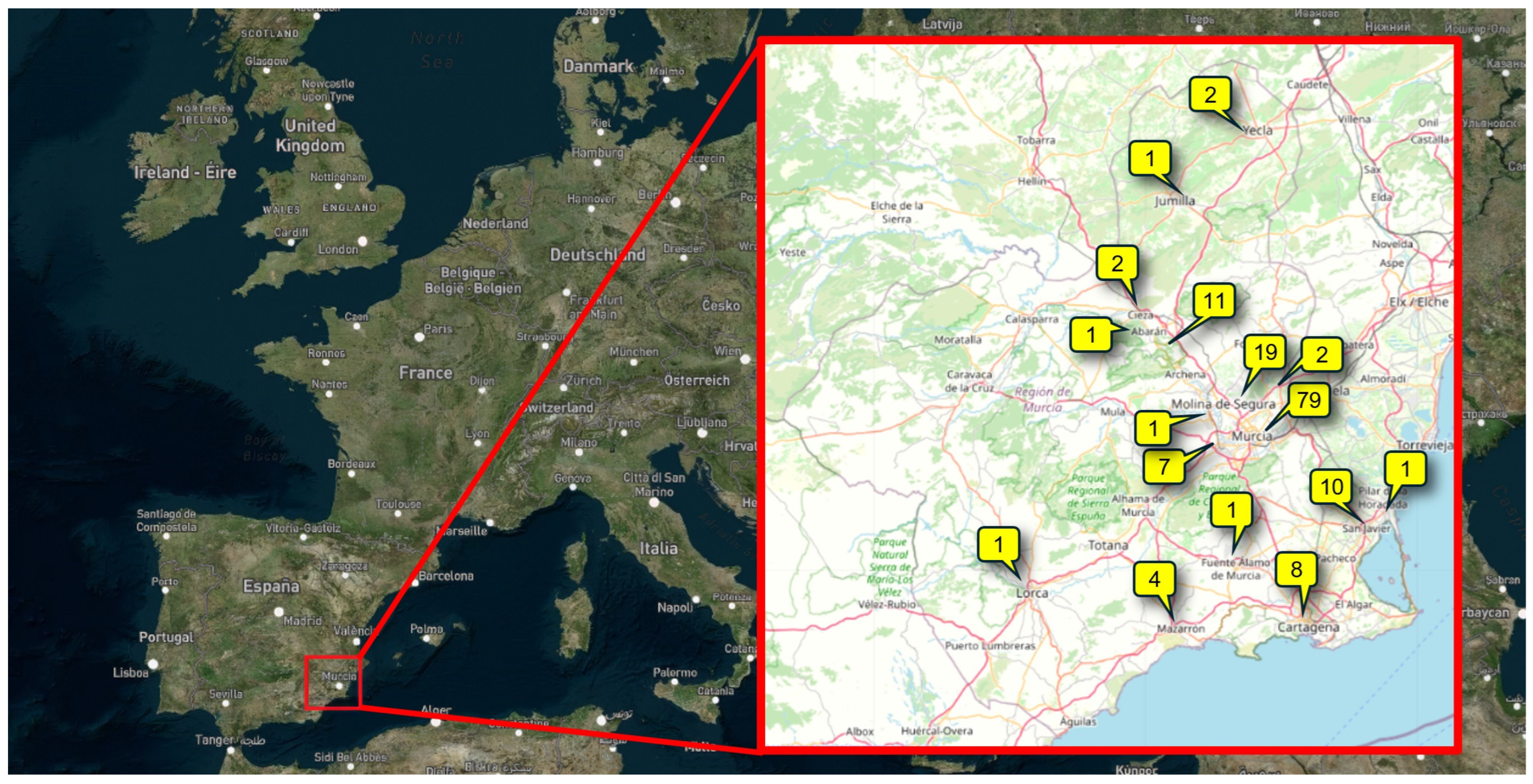




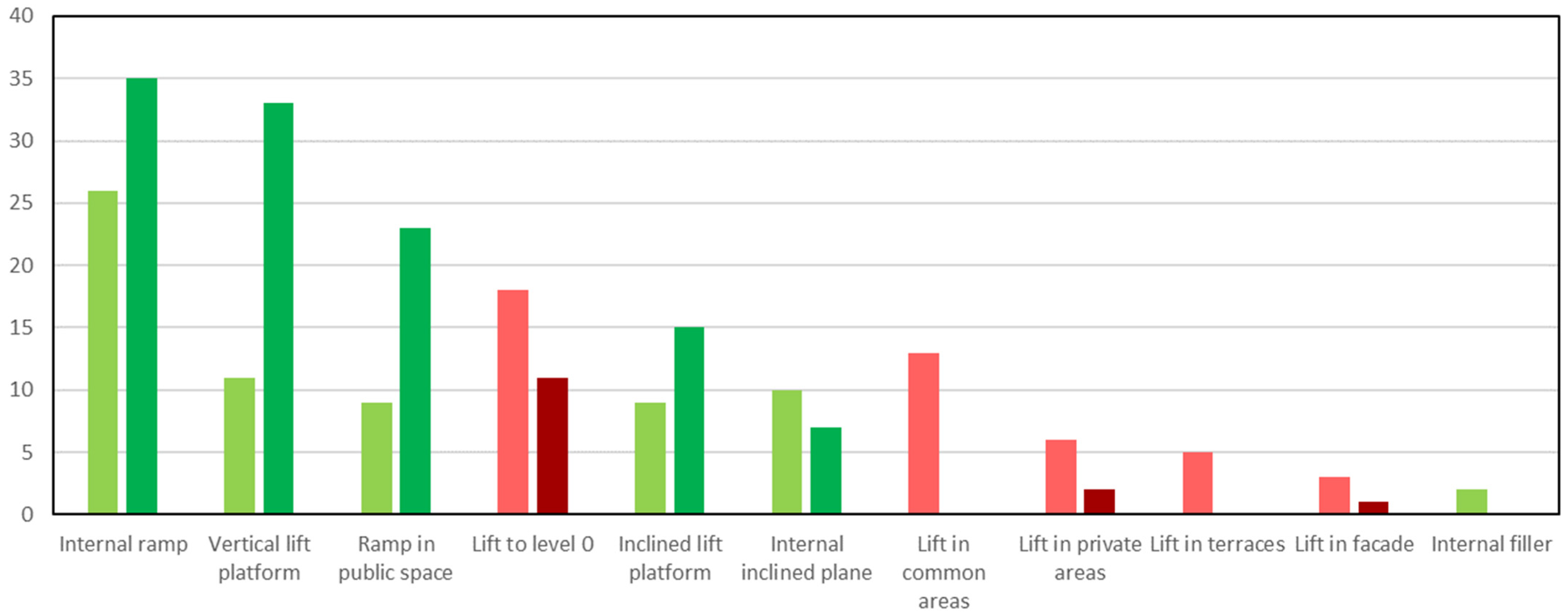
| Question | Action/Comment | |
|---|---|---|
| What is the difference in level at the entrance to the building? | ||
| C1—If there is a height difference, how is it bridged? | C11—By means of a ramp? How wide, long and steep? | Measure the width, slope, and length of the existing ramp at the entrance. |
| C12—Does it meet the requirements of DB SUA? | Minimum width: 1.20 m. Maximum slope:
| |
| C13—If it does not meet the requirements of DB SUA, does it meet the requirements of DA DB SUA/2? | Minimum width: 0.90 m free between handrails. Maximum slope:
| |
| C14—By means of a staircase, according to DB SUA? | Measure the staircase and evaluate the construction of a ramp. How high does it rise? Minimum width: 1 m if it complies with the evacuation width according to DB SI. Minimum tread depth: 28 cm. Maximum rung riser: 18.5 cm. No molder plane allowed. Plateau dimensions: ≥1.00 × 1.00 m. Handrail height: 90–110 cm. Handrail section: 3–5 cm. Separation of handrail from wall: ≥4 cm. | |
| C15—By means of a staircase, according to DA DB SUA/2? | Measure the staircase and evaluate the construction of a ramp. How high does it rise? Minimum width: 0.80 m if it complies with the evacuation width according to DB SI. Minimum tread depth: 28 cm (25 cm if there are up to 8 dwellings). Maximum step riser: 18.5 cm (20 cm if up to 8 dwellings). No molder plane allowed. Plateau dimensions: ≥0.80 × 0.80 m. Handrail height: 90–110 cm. Handrail section: 3–5 cm. Separation of handrail from wall: ≥4 cm. | |
| C16—By means of a mechanical device? By a vertical lift platform? | Check whether the device complies with the requirements of DA DB-SUA/2. Minimum dimensions of the vertical lift platform, clear of the door sweep:
| |
| C17—By means of a mechanical device? By an inclined lift platform (stairlift)? | Check whether the device complies with the requirements of DA DB-SUA/2. Minimum dimensions of the inclined platform lift:
| |
| C2—If there is a difference in level saved by a staircase | C21—Can an accessible ramp be built? | Evaluate the possibility of building a ramp according to the requirements of DB SUA indicated in the previous section. If this is not possible, evaluate the possibility of building a ramp with the requirements of DA DB-SUA /2 indicated in the previous section. |
| C22—If an accessible ramp cannot be built, can a vertical platform lift be installed? | Measure available space for the installation of the vertical platform lift according to the requirements indicated in the previous section. | |
| C23—If a vertical lift platform cannot be installed, can an inclined lift platform be installed? | Measure the available stairway width for the installation of the inclined platform lift according to the requirements indicated in the previous section. | |
| C24—If an inclined platform lift cannot be installed, is it possible to intervene in the public space? | Assess public space, the minimum width of which after the intervention should be greater or equal to 1.80 m. | |
| Is there an elevator to reach the floors? | ||
| C3—If there is an elevator | C31—What is the difference in height between the access and the elevator level? | Measure the height difference between the elevator and the access, and how it is bridged. |
| C32—If there is a difference, can the elevator be lowered to level 0? | Evaluate the possibility of lowering the elevator to level 0 by means of an intervention in the hallway. | |
| C33—If not, can an accessible ramp be built to reach the elevator level from the access? | Measure the height between the elevator and the access and the existing length, and evaluate if it is possible to build a ramp according to the requirements of DB SUA indicated in the previous section. If it is not possible, evaluate the possibility of building a ramp according to the requirements of DA DB SUA/2 indicated in the previous section. | |
| C34—If an accessible ramp cannot be built, can a vertical lift platform be installed? | Measure available space for the installation of the vertical platform lift width according to the requirements indicated in the previous section. | |
| C35—If a vertical lift platform cannot be installed, can an inclined lift platform be installed? | Measure the available space of the stairs’ width for the installation of the inclined lift platform. | |
| C36—Is there a garage in the building? Does the elevator reach the garage? | If there is a garage but the elevator does not reach it, study how to connect the elevator to the garage. | |
| C37—What are the dimensions of the elevator shaft? | Measure the dimension of the existing shaft, to locate the maximum possible cabin size. | |
| C38—What are the cabin dimensions of the elevator? | Check that it has the following minimum cabin dimension (according to DB SUA):
| |
If the above is not met, check that it has the following minimum cabin dimension (according to DA DB SUA/2):
| ||
| C39—Does the elevator reach all floors, including the terrace? | If not met, evaluate the possibility of making adaptations to reach all plants. | |
| C4—If there is no elevator | C41—How wide is the vertical communication core? | Measure and check the dimension of the vertical communication core. |
| C42—Does it allow the installation of an elevator in common areas? | Check the remaining dimension, as indicated above, after subtracting the minimum stair width. | |
| C43—If not, does it allow the installation of an elevator in the terrace? | Measure and check the terrace dimension after installing an elevator according to the indicated requirements of DB SUA. If it does not meet the requirements, measure and check the terrace dimension after installing an elevator according to the indicated requirements of DA DB- SUA/2. | |
| C44—If not, does it allow the installation of an elevator in private areas? | Measure and check the dimensions and frame of private areas after installing an elevator according to the requirements of DB SUA. If it does not meet the requirements, measure and check the dimensions and frame of private areas after installing an elevator according to the requirements of DA DB- SUA/2. | |
| C45—If not, does it allow the installation of a facade elevator? | Measure and check the dimension of the public space after installing a facade elevator. | |
Disclaimer/Publisher’s Note: The statements, opinions and data contained in all publications are solely those of the individual author(s) and contributor(s) and not of MDPI and/or the editor(s). MDPI and/or the editor(s) disclaim responsibility for any injury to people or property resulting from any ideas, methods, instructions or products referred to in the content. |
© 2024 by the authors. Licensee MDPI, Basel, Switzerland. This article is an open access article distributed under the terms and conditions of the Creative Commons Attribution (CC BY) license (https://creativecommons.org/licenses/by/4.0/).
Share and Cite
Mayordomo-Martínez, D.; García-Mateos, G. Evaluating Accessibility Solutions in Collective Residential Buildings: Field Research in Southeast Spain. Buildings 2024, 14, 1621. https://doi.org/10.3390/buildings14061621
Mayordomo-Martínez D, García-Mateos G. Evaluating Accessibility Solutions in Collective Residential Buildings: Field Research in Southeast Spain. Buildings. 2024; 14(6):1621. https://doi.org/10.3390/buildings14061621
Chicago/Turabian StyleMayordomo-Martínez, Diego, and Ginés García-Mateos. 2024. "Evaluating Accessibility Solutions in Collective Residential Buildings: Field Research in Southeast Spain" Buildings 14, no. 6: 1621. https://doi.org/10.3390/buildings14061621
APA StyleMayordomo-Martínez, D., & García-Mateos, G. (2024). Evaluating Accessibility Solutions in Collective Residential Buildings: Field Research in Southeast Spain. Buildings, 14(6), 1621. https://doi.org/10.3390/buildings14061621






